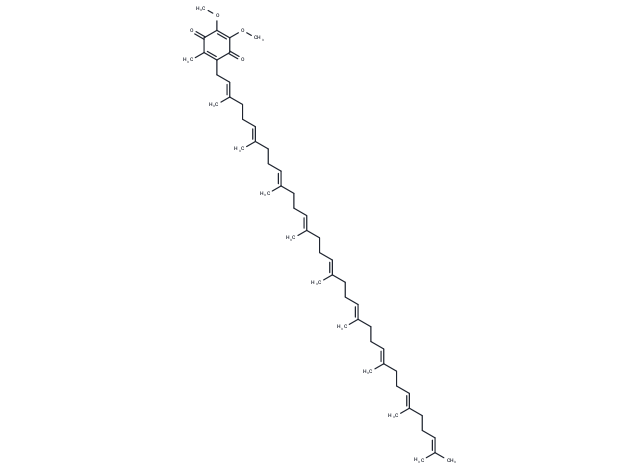Shopping Cart
- Remove All
 Your shopping cart is currently empty
Your shopping cart is currently empty

Coenzyme Q9 (Ubiquinone 9) (CoQ9) is a normal constituent of human plasma. CoQ9 in human plasma may originate as a product of incomplete CoQ10 biosynthesis or from the diet.

| Pack Size | Price | Availability | Quantity |
|---|---|---|---|
| 1 mg | $52 | In Stock | |
| 5 mg | $128 | In Stock | |
| 10 mg | $190 | In Stock | |
| 25 mg | $283 | In Stock | |
| 50 mg | $418 | In Stock | |
| 100 mg | $623 | In Stock |
| Description | Coenzyme Q9 (Ubiquinone 9) (CoQ9) is a normal constituent of human plasma. CoQ9 in human plasma may originate as a product of incomplete CoQ10 biosynthesis or from the diet. |
| In vitro | Coenzyme Q9 were cardioprotective, as evidenced by their abilities to improve left ventricular performance and to reduce myocardial infarct size and cardiomyocyte apoptosis[1]. |
| In vivo | Mutations in the gene that encodes Coenzyme Q9(CoQ9) are associated with encephalomyopathy and autosomal-recessive, neonatal-onset, primary CoQ10 deficiency.While in humans CoQ10 predominates, mice and C. elegans primarily rely on CoQ9 for electron transport through the mitochondrial respiratory chain and for antioxidant functions[2,3]. |
| Animal Research | Guinea pigs were randomly divided into three groups: groups I and II were fed CoQ 9 and CoQ10, respectively, for 30 days while group III served as control.?After 30 days, the guinea pigs were sacrificed and isolated hearts were perfused via working mode were subjected to 30 min ischemia followed by 2 h of reperfusion.?Cardioprotection was assessed by evaluating left ventricular function, ventricular arrhythmias, myocardial infarct size, and cardiomyocyte apoptosis.?Samples of hearts were examined for the presence of CoQ9 and CoQ10[1]. |
| Alias | Ubiquinone Q9, Ubiquinone 9, CoQ9 |
| Molecular Weight | 795.23 |
| Formula | C54H82O4 |
| Cas No. | 303-97-9 |
| Smiles | COC1=C(OC)C(=O)C(C\C=C(/C)CC\C=C(/C)CC\C=C(/C)CC\C=C(/C)CC\C=C(/C)CC\C=C(/C)CC\C=C(/C)CC\C=C(/C)CCC=C(C)C)=C(C)C1=O |
| Relative Density. | 0.97 g/cm3 (Predicted) |
| Storage | keep away from direct sunlight | Powder: -20°C for 3 years | In solvent: -80°C for 1 year | Shipping with blue ice. |
| Solubility Information | DMSO: < 1 mg/mL (insoluble) |

Copyright © 2015-2024 TargetMol Chemicals Inc. All Rights Reserved.